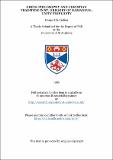Files in this item
Greek philosophy and christian tradition in St. Gregory of Nazianzus : unity-triplicity
Item metadata
| dc.contributor.author | Lialiou, Despo Ath. | |
| dc.coverage.spatial | ii, 289 p. | en_US |
| dc.date.accessioned | 2018-06-05T15:19:17Z | |
| dc.date.available | 2018-06-05T15:19:17Z | |
| dc.date.issued | 1982-07 | |
| dc.identifier.uri | https://hdl.handle.net/10023/13737 | |
| dc.description.abstract | The purpose of this thesis is the analysis of the way by which St. Gregory the Theologian used Greek philosophy and religious ideas of Classical Hellenism in order to formulate the Christian Trinitarian Dogma, which, according to St. Gregory, is the only and unique criterion for approaching "δρνοδόξωσ" the Christian Cosmology and Anthropology. The very confusion between Greek philosophy and the dogmatic doctrine of Greek Fathers stems from the fact that a common terminology exists on both side. This was not a matter of confusion for St. Gregory since he understood the Holy Dispensation as the very mystery of God's manifestation through the history of Creation. Exposing the theological presuppositions he defines the Framework according to which the Orthodox theologian must theologize without running the risk of becoming a heretic. Purification, inactivity, and finally theoria constitutes the life of the theologian par excellence. The O.T. and the N.T. as well as the Ecclesiastical tradition are the sources of the Orthodox Dogma, the declaration of which is characterized by measure and symmetry (Via Media), in contrast to the heretical views which always move to extremes. Furthermore for St. Gregory the Christian theologian is the true philosopher who after painful preparation reaches such a level of objectivity that he becomes a voice of the Holy Spirit. In the same framework of theological objectivity St. Gregory examines the divine Names. He classifies Them into, a) Names proper to Essence, and b) Common Names of the divine Authority and of Dispensation. This latter introduces the Triplicity of the Persons within the Godhead, whereas the Former ones state Its Unit. On the other hand St. Gregory is particularly aware of Greek Monotheism, either that of the philosophers or of theurgical religion but he calls the latter polytheia because of its abstract notion of Oneness for a multiplicity of gods. In addition, instead of an abstract essence of the philosophers and their theory of ontological subordination of the Hypostaseis, a theory which leads towards coeternity of the ultimate Principle with Creation, St. Gregory introduces the paradoxical schema "Μονὰσ ἐγ Τριάδι", and vice versa, and in so doing he excludes a non-hypostatized essence or three non-substantial Hypostaseis. St. Gregory follows St. Athanasius concerning the Trinitarian Dogma and shares with the so called Cappadocian Fathers the main characteristics of the Cappadocian Trinitarian doctrine about Unity and Triplicity of God. Furthermore he uses the term homoousion to safeguard and confess the Unity of the three Hypostaseis and to declare unambiguously the divinity of the Holy Spirit, Whom he clearly calls "θεόσ". This statement is St. Gregory's personal contribution to formulation of the Trinitarian Dogma, a point that later became the rule of Orthodoxy, particularly concerning the Eastern Church. The last chapter is devoted to the question of the Trinitarian Images., which the heretics used in order to explain away the "παράδοζογ" character of the theologia by means of logical devices. Although St. Gregory is reluctant to apply images borrowed from the created nature to the Persons of the Holy Trinity, he does do so in a moderate and qualified way in order to expose and refute only the heretical positions. | en_US |
| dc.language.iso | en | en_US |
| dc.publisher | University of St Andrews | |
| dc.subject.lcc | BR1720.G7L5 | en |
| dc.subject.lcsh | Gregory, of Nazianzus, Saint | en |
| dc.title | Greek philosophy and christian tradition in St. Gregory of Nazianzus : unity-triplicity | en_US |
| dc.type | Thesis | en_US |
| dc.type.qualificationlevel | Doctoral | en_US |
| dc.publisher.institution | The University of St Andrews | en_US |
This item appears in the following Collection(s)
Items in the St Andrews Research Repository are protected by copyright, with all rights reserved, unless otherwise indicated.

